实例介绍
【实例简介】Foundations of Machine Learning
One of the most classical machine learning books
【实例截图】


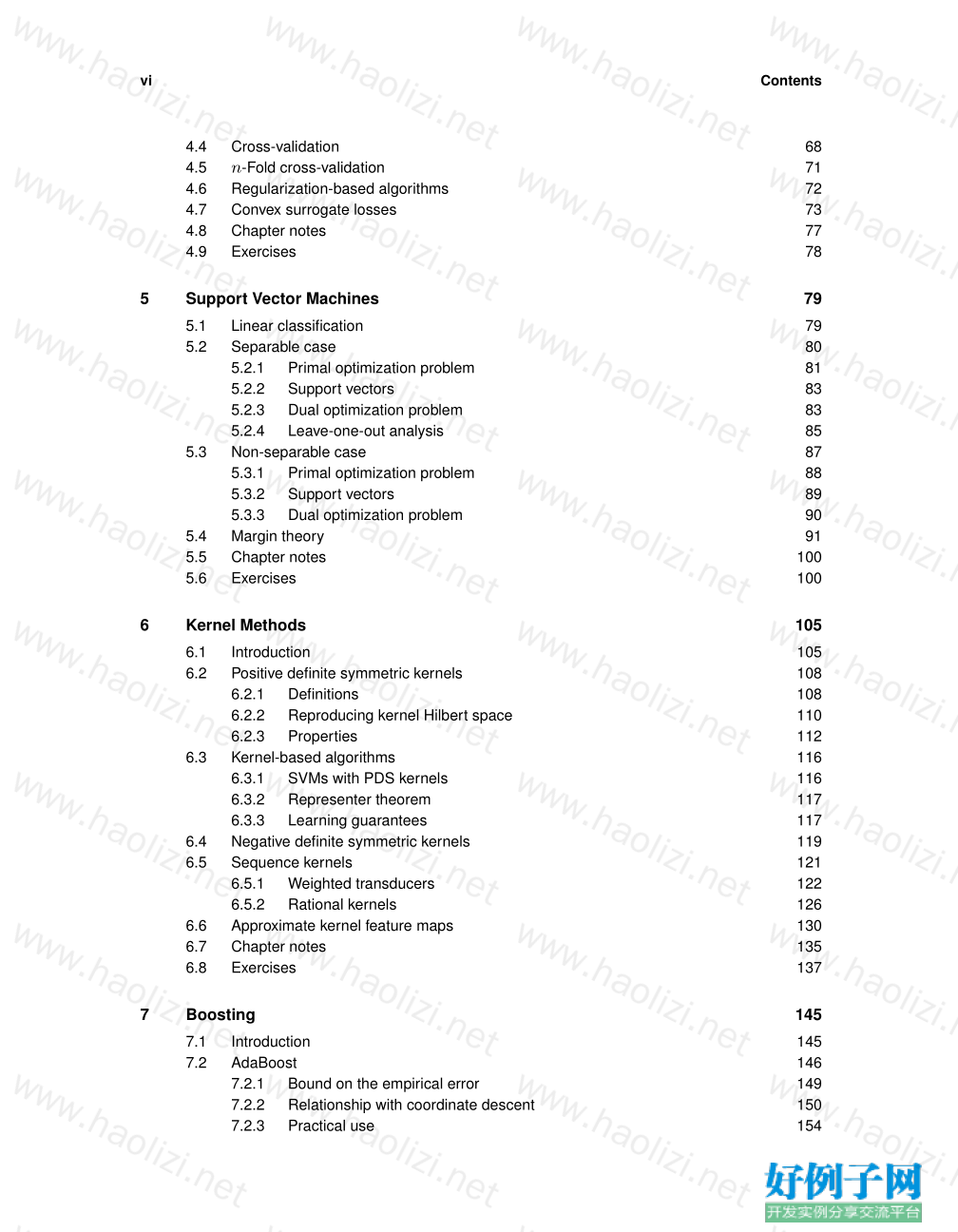
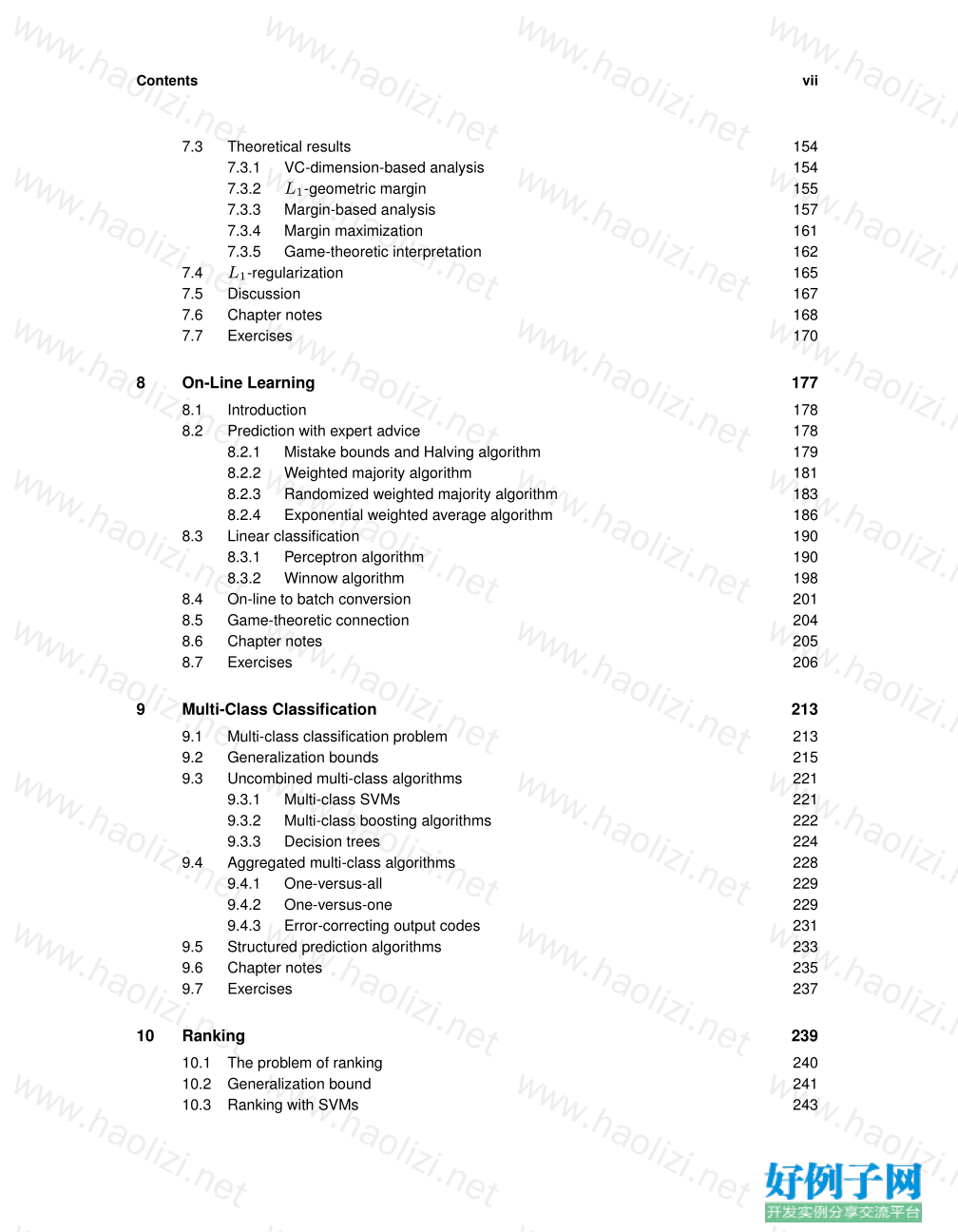
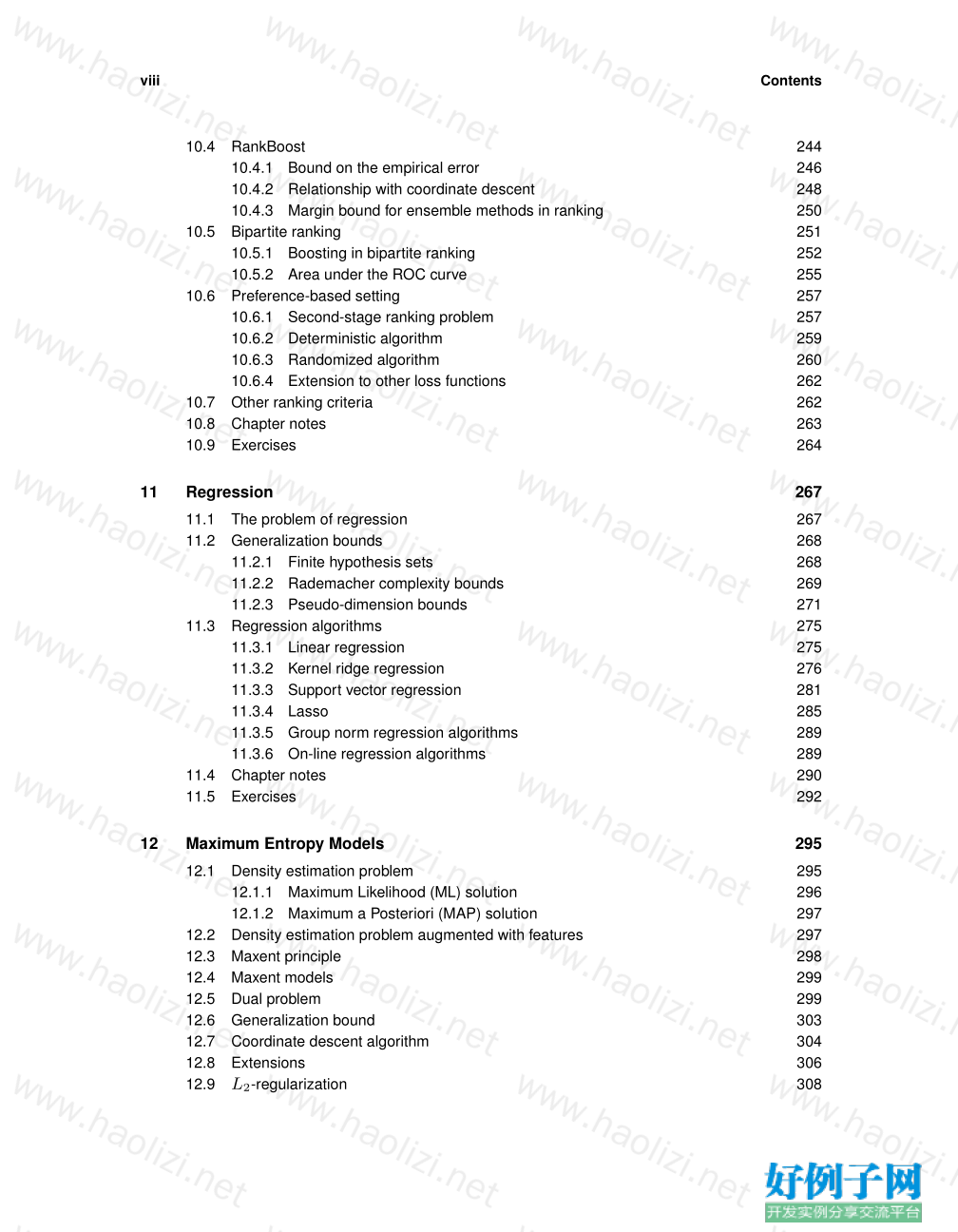
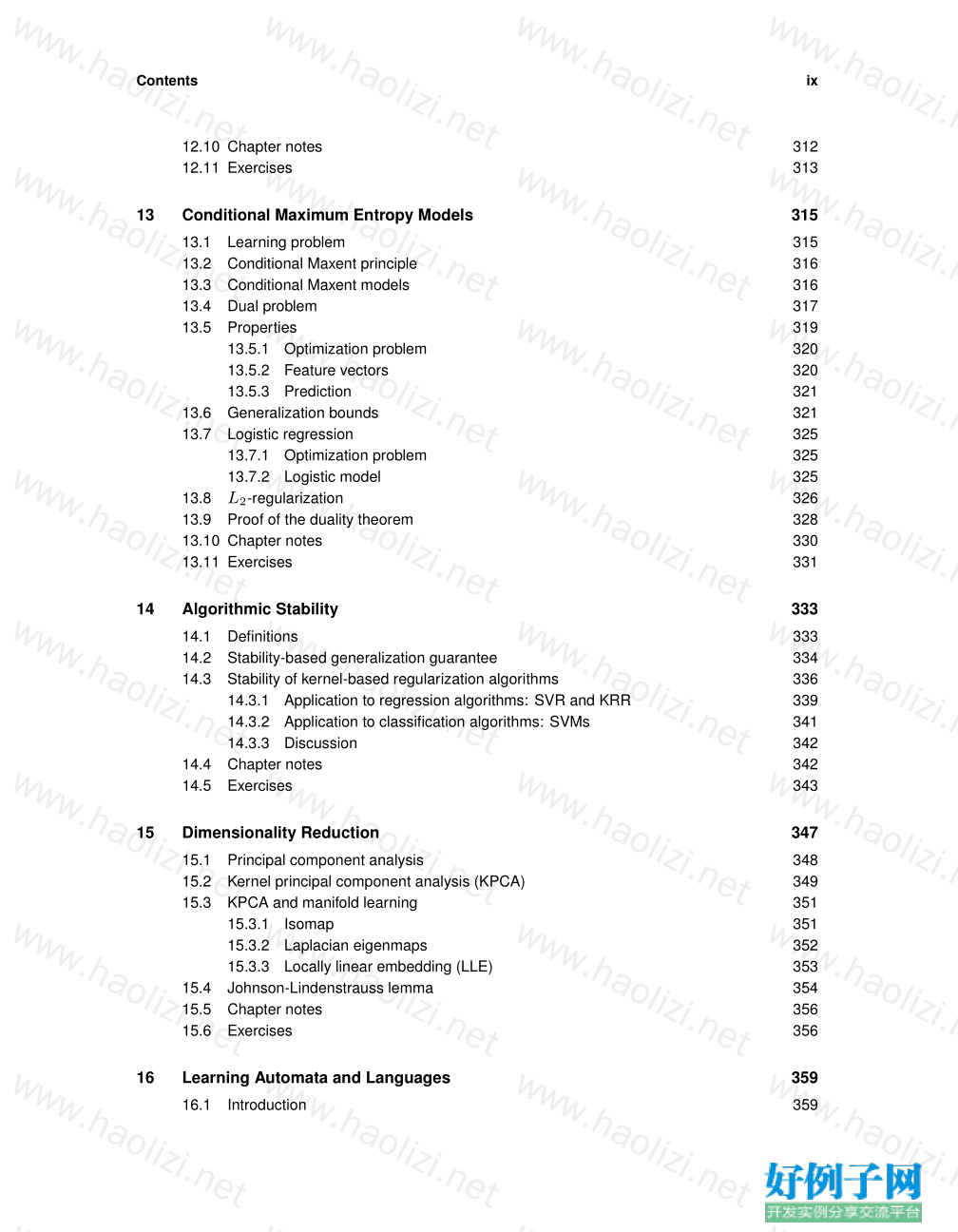
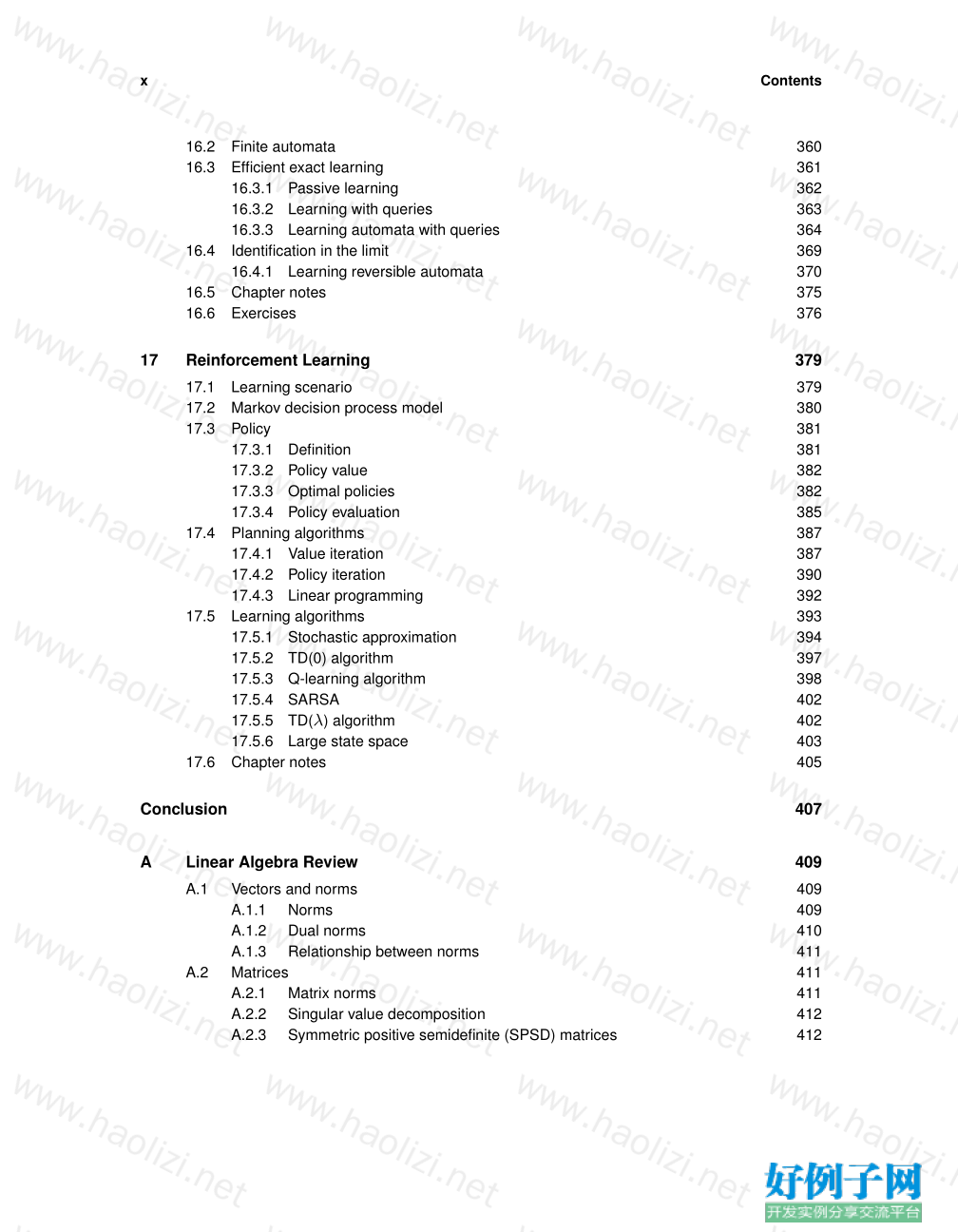
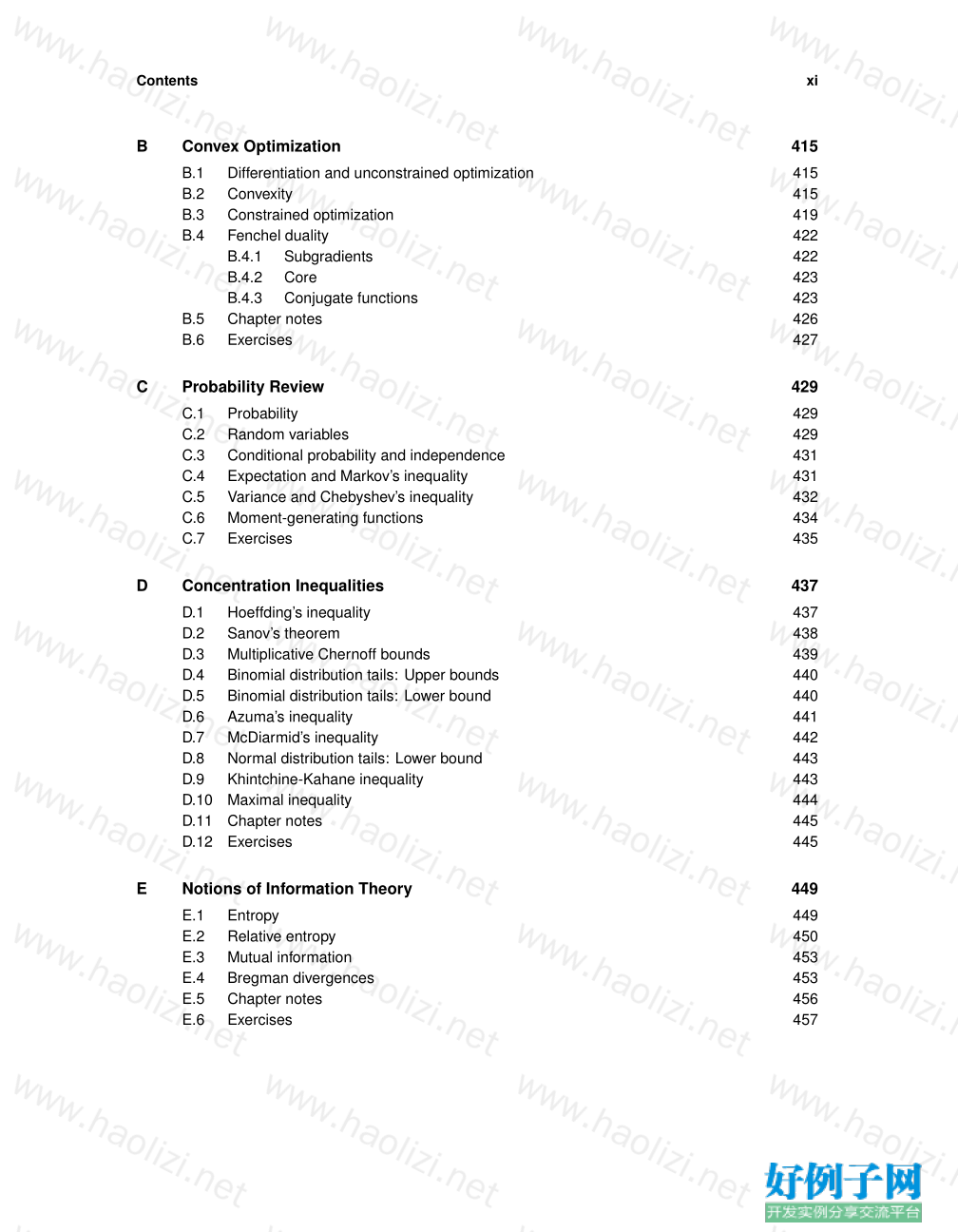

【核心代码】
Contents
Preface xiii
1 Introduction 1
1.1 What is machine learning? 1
1.2 What kind of problems can be tackled using machine learning? 2
1.3 Some standard learning tasks 3
1.4 Learning stages 4
1.5 Learning scenarios 6
1.6 Generalization 7
2 The PAC Learning Framework 9
2.1 The PAC learning model 9
2.2 Guarantees for finite hypothesis sets — consistent case 15
2.3 Guarantees for finite hypothesis sets — inconsistent case 19
2.4 Generalities 21
2.4.1 Deterministic versus stochastic scenarios 21
2.4.2 Bayes error and noise 22
2.5 Chapter notes 23
2.6 Exercises 23
3 Rademacher Complexity and VC-Dimension 29
3.1 Rademacher complexity 30
3.2 Growth function 34
3.3 VC-dimension 36
3.4 Lower bounds 43
3.5 Chapter notes 48
3.6 Exercises 50
4 Model Selection 61
4.1 Estimation and approximation errors 61
4.2 Empirical risk minimization (ERM) 62
4.3 Structural risk minimization (SRM) 64
vi Contents
4.4 Cross-validation 68
4.5 n -Fold cross-validation 71
4.6 Regularization-based algorithms 72
4.7 Convex surrogate losses 73
4.8 Chapter notes 77
4.9 Exercises 78
5 Support Vector Machines 79
5.1 Linear classification 79
5.2 Separable case 80
5.2.1 Primal optimization problem 81
5.2.2 Support vectors 83
5.2.3 Dual optimization problem 83
5.2.4 Leave-one-out analysis 85
5.3 Non-separable case 87
5.3.1 Primal optimization problem 88
5.3.2 Support vectors 89
5.3.3 Dual optimization problem 90
5.4 Margin theory 91
5.5 Chapter notes 100
5.6 Exercises 100
6 Kernel Methods 105
6.1 Introduction 105
6.2 Positive definite symmetric kernels 108
6.2.1 Definitions 108
6.2.2 Reproducing kernel Hilbert space 110
6.2.3 Properties 112
6.3 Kernel-based algorithms 116
6.3.1 SVMs with PDS kernels 116
6.3.2 Representer theorem 117
6.3.3 Learning guarantees 117
6.4 Negative definite symmetric kernels 119
6.5 Sequence kernels 121
6.5.1 Weighted transducers 122
6.5.2 Rational kernels 126
6.6 Approximate kernel feature maps 130
6.7 Chapter notes 135
6.8 Exercises 137
7 Boosting 145
7.1 Introduction 145
7.2 AdaBoost 146
7.2.1 Bound on the empirical error 149
7.2.2 Relationship with coordinate descent 150
7.2.3 Practical use 154
Contents vii
7.3 Theoretical results 154
7.3.1 VC-dimension-based analysis 154
7.3.2 L 1 -geometric margin 155
7.3.3 Margin-based analysis 157
7.3.4 Margin maximization 161
7.3.5 Game-theoretic interpretation 162
7.4 L 1 -regularization 165
7.5 Discussion 167
7.6 Chapter notes 168
7.7 Exercises 170
8 On-Line Learning 177
8.1 Introduction 178
8.2 Prediction with expert advice 178
8.2.1 Mistake bounds and Halving algorithm 179
8.2.2 Weighted majority algorithm 181
8.2.3 Randomized weighted majority algorithm 183
8.2.4 Exponential weighted average algorithm 186
8.3 Linear classification 190
8.3.1 Perceptron algorithm 190
8.3.2 Winnow algorithm 198
8.4 On-line to batch conversion 201
8.5 Game-theoretic connection 204
8.6 Chapter notes 205
8.7 Exercises 206
9 Multi-Class Classification 213
9.1 Multi-class classification problem 213
9.2 Generalization bounds 215
9.3 Uncombined multi-class algorithms 221
9.3.1 Multi-class SVMs 221
9.3.2 Multi-class boosting algorithms 222
9.3.3 Decision trees 224
9.4 Aggregated multi-class algorithms 228
9.4.1 One-versus-all 229
9.4.2 One-versus-one 229
9.4.3 Error-correcting output codes 231
9.5 Structured prediction algorithms 233
9.6 Chapter notes 235
9.7 Exercises 237
10 Ranking 239
10.1 The problem of ranking 240
10.2 Generalization bound 241
10.3 Ranking with SVMs 243
viii Contents
10.4 RankBoost 244
10.4.1 Bound on the empirical error 246
10.4.2 Relationship with coordinate descent 248
10.4.3 Margin bound for ensemble methods in ranking 250
10.5 Bipartite ranking 251
10.5.1 Boosting in bipartite ranking 252
10.5.2 Area under the ROC curve 255
10.6 Preference-based setting 257
10.6.1 Second-stage ranking problem 257
10.6.2 Deterministic algorithm 259
10.6.3 Randomized algorithm 260
10.6.4 Extension to other loss functions 262
10.7 Other ranking criteria 262
10.8 Chapter notes 263
10.9 Exercises 264
11 Regression 267
11.1 The problem of regression 267
11.2 Generalization bounds 268
11.2.1 Finite hypothesis sets 268
11.2.2 Rademacher complexity bounds 269
11.2.3 Pseudo-dimension bounds 271
11.3 Regression algorithms 275
11.3.1 Linear regression 275
11.3.2 Kernel ridge regression 276
11.3.3 Support vector regression 281
11.3.4 Lasso 285
11.3.5 Group norm regression algorithms 289
11.3.6 On-line regression algorithms 289
11.4 Chapter notes 290
11.5 Exercises 292
12 Maximum Entropy Models 295
12.1 Density estimation problem 295
12.1.1 Maximum Likelihood (ML) solution 296
12.1.2 Maximum a Posteriori (MAP) solution 297
12.2 Density estimation problem augmented with features 297
12.3 Maxent principle 298
12.4 Maxent models 299
12.5 Dual problem 299
12.6 Generalization bound 303
12.7 Coordinate descent algorithm 304
12.8 Extensions 306
12.9 L 2 -regularization 308
Contents ix
12.10 Chapter notes 312
12.11 Exercises 313
13 Conditional Maximum Entropy Models 315
13.1 Learning problem 315
13.2 Conditional Maxent principle 316
13.3 Conditional Maxent models 316
13.4 Dual problem 317
13.5 Properties 319
13.5.1 Optimization problem 320
13.5.2 Feature vectors 320
13.5.3 Prediction 321
13.6 Generalization bounds 321
13.7 Logistic regression 325
13.7.1 Optimization problem 325
13.7.2 Logistic model 325
13.8 L 2 -regularization 326
13.9 Proof of the duality theorem 328
13.10 Chapter notes 330
13.11 Exercises 331
14 Algorithmic Stability 333
14.1 Definitions 333
14.2 Stability-based generalization guarantee 334
14.3 Stability of kernel-based regularization algorithms 336
14.3.1 Application to regression algorithms: SVR and KRR 339
14.3.2 Application to classification algorithms: SVMs 341
14.3.3 Discussion 342
14.4 Chapter notes 342
14.5 Exercises 343
15 Dimensionality Reduction 347
15.1 Principal component analysis 348
15.2 Kernel principal component analysis (KPCA) 349
15.3 KPCA and manifold learning 351
15.3.1 Isomap 351
15.3.2 Laplacian eigenmaps 352
15.3.3 Locally linear embedding (LLE) 353
15.4 Johnson-Lindenstrauss lemma 354
15.5 Chapter notes 356
15.6 Exercises 356
16 Learning Automata and Languages 359
16.1 Introduction 359
x Contents
16.2 Finite automata 360
16.3 Efficient exact learning 361
16.3.1 Passive learning 362
16.3.2 Learning with queries 363
16.3.3 Learning automata with queries 364
16.4 Identification in the limit 369
16.4.1 Learning reversible automata 370
16.5 Chapter notes 375
16.6 Exercises 376
17 Reinforcement Learning 379
17.1 Learning scenario 379
17.2 Markov decision process model 380
17.3 Policy 381
17.3.1 Definition 381
17.3.2 Policy value 382
17.3.3 Optimal policies 382
17.3.4 Policy evaluation 385
17.4 Planning algorithms 387
17.4.1 Value iteration 387
17.4.2 Policy iteration 390
17.4.3 Linear programming 392
17.5 Learning algorithms 393
17.5.1 Stochastic approximation 394
17.5.2 TD(0) algorithm 397
17.5.3 Q-learning algorithm 398
17.5.4 SARSA 402
17.5.5 TD( λ ) algorithm 402
17.5.6 Large state space 403
17.6 Chapter notes 405
Conclusion 407
A Linear Algebra Review 409
A.1 Vectors and norms 409
A.1.1 Norms 409
A.1.2 Dual norms 410
A.1.3 Relationship between norms 411
A.2 Matrices 411
A.2.1 Matrix norms 411
A.2.2 Singular value decomposition 412
A.2.3 Symmetric positive semidefinite (SPSD) matrices 412
Contents xi
B Convex Optimization 415
B.1 Differentiation and unconstrained optimization 415
B.2 Convexity 415
B.3 Constrained optimization 419
B.4 Fenchel duality 422
B.4.1 Subgradients 422
B.4.2 Core 423
B.4.3 Conjugate functions 423
B.5 Chapter notes 426
B.6 Exercises 427
C Probability Review 429
C.1 Probability 429
C.2 Random variables 429
C.3 Conditional probability and independence 431
C.4 Expectation and Markov’s inequality 431
C.5 Variance and Chebyshev’s inequality 432
C.6 Moment-generating functions 434
C.7 Exercises 435
D Concentration Inequalities 437
D.1 Hoeffding’s inequality 437
D.2 Sanov’s theorem 438
D.3 Multiplicative Chernoff bounds 439
D.4 Binomial distribution tails: Upper bounds 440
D.5 Binomial distribution tails: Lower bound 440
D.6 Azuma’s inequality 441
D.7 McDiarmid’s inequality 442
D.8 Normal distribution tails: Lower bound 443
D.9 Khintchine-Kahane inequality 443
D.10 Maximal inequality 444
D.11 Chapter notes 445
D.12 Exercises 445
E Notions of Information Theory 449
E.1 Entropy 449
E.2 Relative entropy 450
E.3 Mutual information 453
E.4 Bregman divergences 453
E.5 Chapter notes 456
E.6 Exercises 457
xii Contents
F Notation 459
Bibliography 461
Index 475
小贴士
感谢您为本站写下的评论,您的评论对其它用户来说具有重要的参考价值,所以请认真填写。
- 类似“顶”、“沙发”之类没有营养的文字,对勤劳贡献的楼主来说是令人沮丧的反馈信息。
- 相信您也不想看到一排文字/表情墙,所以请不要反馈意义不大的重复字符,也请尽量不要纯表情的回复。
- 提问之前请再仔细看一遍楼主的说明,或许是您遗漏了。
- 请勿到处挖坑绊人、招贴广告。既占空间让人厌烦,又没人会搭理,于人于己都无利。
关于好例子网
本站旨在为广大IT学习爱好者提供一个非营利性互相学习交流分享平台。本站所有资源都可以被免费获取学习研究。本站资源来自网友分享,对搜索内容的合法性不具有预见性、识别性、控制性,仅供学习研究,请务必在下载后24小时内给予删除,不得用于其他任何用途,否则后果自负。基于互联网的特殊性,平台无法对用户传输的作品、信息、内容的权属或合法性、安全性、合规性、真实性、科学性、完整权、有效性等进行实质审查;无论平台是否已进行审查,用户均应自行承担因其传输的作品、信息、内容而可能或已经产生的侵权或权属纠纷等法律责任。本站所有资源不代表本站的观点或立场,基于网友分享,根据中国法律《信息网络传播权保护条例》第二十二与二十三条之规定,若资源存在侵权或相关问题请联系本站客服人员,点此联系我们。关于更多版权及免责申明参见 版权及免责申明



网友评论
我要评论